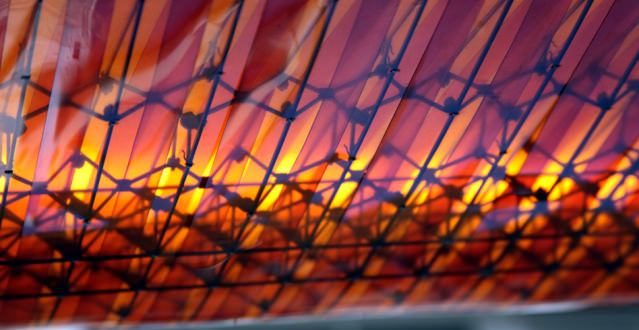A team from MIT and NASA led by Neil Gershenfeld is developing a new type of “morphing” wing that rather than using conventional flaps, changes its shape.
This new wing is made up of overlapping strips that could be assembled by small robots, resulting in aircraft that are simpler to build, use less fuel, and boast improved agility.
The materials scientists ditched the conventional system—using millions of different bits of metal, composites, and plastics to make a wing—for just eight basic elements. Those resemble kids’ building blocks, but are black, slightly squishy, and made of carbon fiber. They assembled an experimental wing about five feet across, wrapping it in a shiny orange flexible skin.
Each of the eight subunits has a different stiffness, so placing the blocks in a specific pattern gives each wing a ‘tunable’ flexibility. Just two small motors are enough to twist the entire wing, adjusting the way it cuts through the air.
“One of the things that we’ve been able to show is that this building block approach can actually achieve better strength and stiffness, at very low weights, than any other material that we build with,” says NASA’S Kenny Cheung, one of the leaders of the project.
Better yet, when the team put the wings onto a dummy plane body and threw it into the wind tunnel at NASA’s Langley Research Center in Virginia, the mock aircraft flashed some terrific aerodynamics. “We maxed out the wind tunnel’s capacity,” says Cheung.
Modern wings rely on flaps to boost lift and shorten take-off and landing distances, and on ailerons to change direction. But when deployed, they create gaps in the edge of the wing, generating turbulent airflow—bad news for efficiency and noise. “They require complex hydraulic and other actuators that add weight, complexity, and things that can go wrong,” adds Mark Sensmeier, an aerospace engineer at Embry-Riddle Aeronautical University.
“Ideally you’d want a smooth contour,” says Kevin Weinert, from Nasa’s Armstrong Flight Research Center. He manages a separate project also looking at ways to ditch flaps. His team has replaced the control surfaces on the wings of a Gulfstream III executive jet with a white, plastic-looking bendy surface that puts corrugated flex points between sections, instead of gaps. Early flights proved the concept, and now test pilots will take the plane up to 0.85 Mach and try twisting the flap replacement to change the lift that the wing produces.
Weinert’s team won’t reveal how its system works, but he says it’s all about what the wings are made of. “With much stronger materials, in the future we won’t have to rely on titanium and aluminum hard surfaces which don’t bend very much, and go to more exotic materials.” NASA partnered with private company, Flexsys, which says on its website it replaces complex metal linkages with flexible, squishable, composite materials.
After their success in the wind tunnel, Cheung and the MIT team pushed their solution further, bolting the wings onto a remote controlled plane. The twist of the wing was almost imperceptible from the ground, making the mechanical system seem more organic.
These new building methods would likely get their start on small drones and unmanned aircraft. “It’s hard to make a wing that’s morphable and deformable, and still have the stiffness you need to carry a lot of weight,” says Sensmeier.
Cheung sees greater things. “I think we could could change the architecture of the aircraft entirely,” he says. He envisions a future where some planes could use flapping wings, for example, when more efficient.
The new concept is described in the journal Soft Robotics.
Agencies/Canadajournal
 Canada Journal – News of the World Articles and videos to bring you the biggest Canadian news stories from across the country every day
Canada Journal – News of the World Articles and videos to bring you the biggest Canadian news stories from across the country every day



